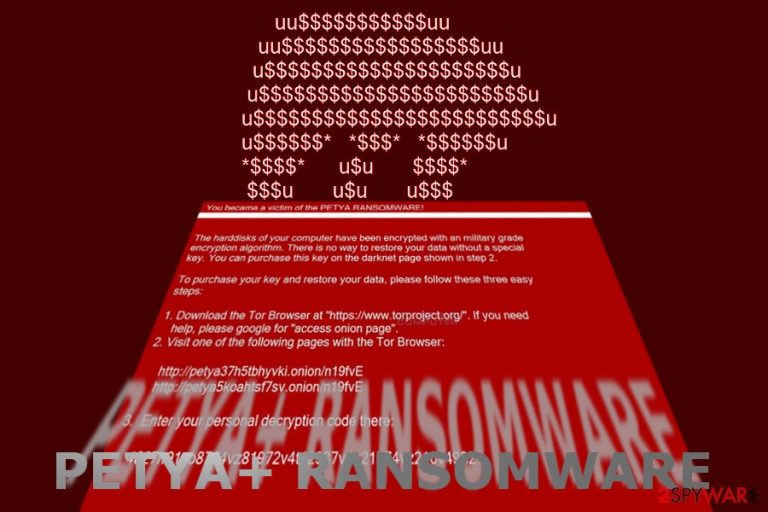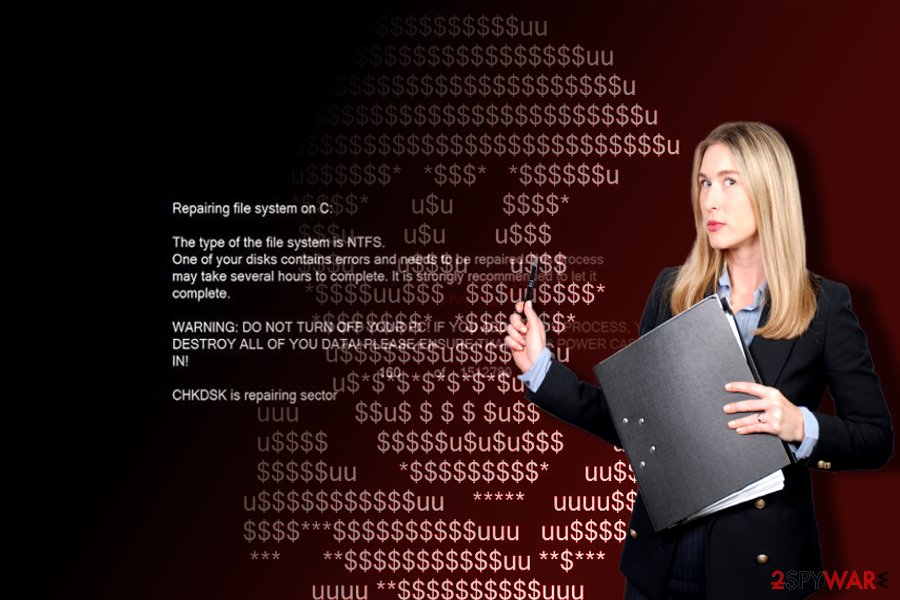Petya+ ransomware / virus (Tutorial) - Free Instructions
Petya+ virus Removal Guide
What is Petya+ ransomware virus?
Another imitator of Petya – Petya+ enters the online market

Petya+ virus is the name of another crypto-malware which aims to share a bit notorious glory of NotPetya/Petya/ExPetr[1] virus. Nonetheless, the malware miserably fails at this mission. Not to mention altered the trademark of Petya – skull – the malware does not encrypt files either.
The ransom note presents a forged notification imitating Windows repair process. It informs a victim that their computer disk is corrupted and needs repair. As the original virus, Petya+ also warns a user not to turn off the device. Though this action won time for the original version, in this case, the message is only a diversion as the malware fails to become a full-fledged virus.
Furthermore, the threat is programmed in .NET language, unlike the original threat which was written with the assistance of the C programming language. The infection activates through Petya+.exe so you can notice it on the Task Manager.
At the moment, only few security applications can detect this malware which disguises under Trojan.Ransom.PetyaScam, Ransom-FakePetya!01A18DB18AF5, or Ransom_FAKEPETYA., however, it is only a matter of time. Fortunately, the ransomware does not succeed its mission but you should remove Petya+ ASAP. For that purpose, FortectIntego or Malwarebytes might serve you.
Fake versions keep popping up
The history repeats itself. Right after WannaCry emerged, new fake versions sprung to life. The same story happens with Petya. Since 27th June, the day when the malware paralyzed the activity multiple companies across the globe, specifically in Europe, such versions as CryForMe, WhyCry virus, kept appearing.
Unfortunately, there were much more destructive malware cases as well. Along with the original threat, FakeCry virus was released as well. Even though it referred to WannaCry, the infection turns out to be a complex file-encrypting threat.
Speaking of the current virus, the malware fails to leave an impression of sophisticated infection. On the one hand, the authors might be praised for imitating Petya ransom and system alerts. Here is an extract from it:
You became a victim of the PETYA RANSOMWARE!
The harddisks of your computer have been encrypted with an military grade encryption algorithm. There is no way to restore your data without a special key. You can purchase this key on the darknet page shown in step 2.
To purchase your key and restore your data, please follow these three easy
steps:
1. Download the Tor Browser at “https://www.torproject.org/”. If you need help, please google for “access onion page”.
2. Visit one of the following pages with the Tor Browser:
hxxx://petya37h5tbhyvki.onion/n19fvE
hxxx://petya5koahtsf7sv.onion/n19fvE
The malware spreads through fewer distribution techniques
The infection has been found targeting users in corrupted websites. There is a chance to get infected when downloading a corrupted torrent file. The romanized ransomware also cooperate with exploit kits. However, the latter are exploited by the cyber criminals of more exquisite threats. 
Since the malware is undeveloped, there is a lower chance that threat is distributed via spam campaign. However, you should not exclude this probability. In order to lower the risk of getting infected, do not only pay attention to the spam folder but make sure you enforce security of the computer. Besides anti-virus, you should install anti-malware and firewall software[2]. Now let us discuss Petya+ removal options.
Ways to eliminate Petya+ threat from Windows OS
Since the virus underperforms as a file-encrypting threat, you can get rid of the threat with the assistance of a cyber security tool. It should perform Petya+ virus and wipe all its elements of lingering registry keys.
However, taking into account, that it still manages to meddle with the boot settings, you may not be able to access the virus-fighting utility. In order to complete Petya+ removal, you may need to launch Safe Mode. More information is provided below. On the final note, Romanian users[3] should be more cautious of this fake imitation of Petya.
Getting rid of Petya+ virus. Follow these steps
Manual removal using Safe Mode
Important! →
Manual removal guide might be too complicated for regular computer users. It requires advanced IT knowledge to be performed correctly (if vital system files are removed or damaged, it might result in full Windows compromise), and it also might take hours to complete. Therefore, we highly advise using the automatic method provided above instead.
Step 1. Access Safe Mode with Networking
Manual malware removal should be best performed in the Safe Mode environment.
Windows 7 / Vista / XP
- Click Start > Shutdown > Restart > OK.
- When your computer becomes active, start pressing F8 button (if that does not work, try F2, F12, Del, etc. – it all depends on your motherboard model) multiple times until you see the Advanced Boot Options window.
- Select Safe Mode with Networking from the list.

Windows 10 / Windows 8
- Right-click on Start button and select Settings.

- Scroll down to pick Update & Security.

- On the left side of the window, pick Recovery.
- Now scroll down to find Advanced Startup section.
- Click Restart now.

- Select Troubleshoot.

- Go to Advanced options.

- Select Startup Settings.

- Press Restart.
- Now press 5 or click 5) Enable Safe Mode with Networking.

Step 2. Shut down suspicious processes
Windows Task Manager is a useful tool that shows all the processes running in the background. If malware is running a process, you need to shut it down:
- Press Ctrl + Shift + Esc on your keyboard to open Windows Task Manager.
- Click on More details.

- Scroll down to Background processes section, and look for anything suspicious.
- Right-click and select Open file location.

- Go back to the process, right-click and pick End Task.

- Delete the contents of the malicious folder.
Step 3. Check program Startup
- Press Ctrl + Shift + Esc on your keyboard to open Windows Task Manager.
- Go to Startup tab.
- Right-click on the suspicious program and pick Disable.

Step 4. Delete virus files
Malware-related files can be found in various places within your computer. Here are instructions that could help you find them:
- Type in Disk Cleanup in Windows search and press Enter.

- Select the drive you want to clean (C: is your main drive by default and is likely to be the one that has malicious files in).
- Scroll through the Files to delete list and select the following:
Temporary Internet Files
Downloads
Recycle Bin
Temporary files - Pick Clean up system files.

- You can also look for other malicious files hidden in the following folders (type these entries in Windows Search and press Enter):
%AppData%
%LocalAppData%
%ProgramData%
%WinDir%
After you are finished, reboot the PC in normal mode.
Remove Petya+ using System Restore
In case you cannot launch Safe Mode, try performing System Restore. This command will revert the system to the last auto-created restore point.
-
Step 1: Reboot your computer to Safe Mode with Command Prompt
Windows 7 / Vista / XP- Click Start → Shutdown → Restart → OK.
- When your computer becomes active, start pressing F8 multiple times until you see the Advanced Boot Options window.
-
Select Command Prompt from the list

Windows 10 / Windows 8- Press the Power button at the Windows login screen. Now press and hold Shift, which is on your keyboard, and click Restart..
- Now select Troubleshoot → Advanced options → Startup Settings and finally press Restart.
-
Once your computer becomes active, select Enable Safe Mode with Command Prompt in Startup Settings window.

-
Step 2: Restore your system files and settings
-
Once the Command Prompt window shows up, enter cd restore and click Enter.

-
Now type rstrui.exe and press Enter again..

-
When a new window shows up, click Next and select your restore point that is prior the infiltration of Petya+. After doing that, click Next.


-
Now click Yes to start system restore.

-
Once the Command Prompt window shows up, enter cd restore and click Enter.
Bonus: Recover your data
Guide which is presented above is supposed to help you remove Petya+ from your computer. To recover your encrypted files, we recommend using a detailed guide prepared by 2-spyware.com security experts.If your files are encrypted by Petya+, you can use several methods to restore them:
What is Data Recovery Pro?
This tool is devised for restoring damaged and corrupted system files. If you fail to escape the trap of ransomware, you may find this program useful.
- Download Data Recovery Pro;
- Follow the steps of Data Recovery Setup and install the program on your computer;
- Launch it and scan your computer for files encrypted by Petya+ ransomware;
- Restore them.
The usefulness of Shadow Explorer
This program exploits shadow volume copies to restore files. This might be your last resort if you failed to backup your files.
- Download Shadow Explorer (http://shadowexplorer.com/);
- Follow a Shadow Explorer Setup Wizard and install this application on your computer;
- Launch the program and go through the drop down menu on the top left corner to select the disk of your encrypted data. Check what folders are there;
- Right-click on the folder you want to restore and select “Export”. You can also select where you want it to be stored.
Finally, you should always think about the protection of crypto-ransomwares. In order to protect your computer from Petya+ and other ransomwares, use a reputable anti-spyware, such as FortectIntego, SpyHunter 5Combo Cleaner or Malwarebytes
How to prevent from getting ransomware
Choose a proper web browser and improve your safety with a VPN tool
Online spying has got momentum in recent years and people are getting more and more interested in how to protect their privacy online. One of the basic means to add a layer of security – choose the most private and secure web browser. Although web browsers can't grant full privacy protection and security, some of them are much better at sandboxing, HTTPS upgrading, active content blocking, tracking blocking, phishing protection, and similar privacy-oriented features. However, if you want true anonymity, we suggest you employ a powerful Private Internet Access VPN – it can encrypt all the traffic that comes and goes out of your computer, preventing tracking completely.
Lost your files? Use data recovery software
While some files located on any computer are replaceable or useless, others can be extremely valuable. Family photos, work documents, school projects – these are types of files that we don't want to lose. Unfortunately, there are many ways how unexpected data loss can occur: power cuts, Blue Screen of Death errors, hardware failures, crypto-malware attack, or even accidental deletion.
To ensure that all the files remain intact, you should prepare regular data backups. You can choose cloud-based or physical copies you could restore from later in case of a disaster. If your backups were lost as well or you never bothered to prepare any, Data Recovery Pro can be your only hope to retrieve your invaluable files.
- ^ Jake Doevan. Petya developers release master decryption key while NotPetya victims are still counting their losses. 2-spyware. IT News and Malware Removal Guides.
- ^ William Wong |. The Advantages of External Firewalls. ElectronicDesign. News and insights.
- ^ How to remove computer viruses. IT News, Reviews and Malware Elimination Instructions.







